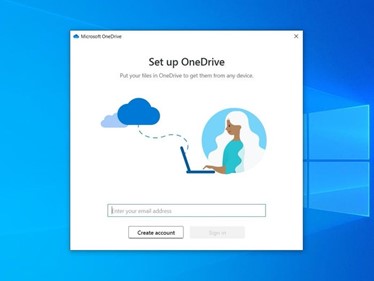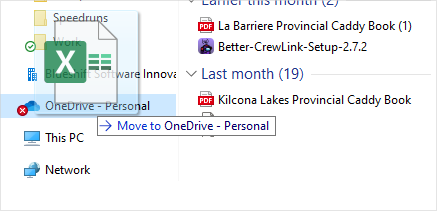We have gone on and on about Sharepoint, Power Platform, and Teams, but let's take a look at a few of the things that we can use ourselves that come in the Microsoft 365 package. We are going to look at OneDrive, the way you can store files, and they can be accessed anytime, anywhere, as long as you have an internet connection. It is a great way to store both personal, and work files, as you can have several accounts logged in at the same time, and don’t have to worry about the cross over between the two, so your boss is never going to see the terrible drafts that you write up.
Logging Into Your OneDrive
When you first turn on your PC, OneDrive will automatically be in your program tray, which is located beside your clock. If you click the up arrow, you will get a listing of the current programs open. Your tray will look something like this (probably minus the gaming things I have installed):
Note: I have OneDrive for Business for Bloom Software (blue icon), and my personal OneDrive (white icon).

If you do not see it in here, go into your search bar in the bottom left, and search for "OneDrive". It will come up and click into it. Once you have opened it, you will get a prompt to set up your OneDrive. We are only going to worry about work-related saves today, so use your work credentials to sign in.

Once you have set it up, you will notice that there is now a OneDrive folder in your navigation panes. This is where all of your folders will be saved, and when you start syncing items, they will be saved here. You will know it is a OneDrive folder, as it will have a blue cloud inside of it. It will look like this:

Reminder: I have one for Bloom Software, and my personal OneDrive.
Adding Files to OneDrive
The first thing that we are going to do now that it is set up is to add folders to our OneDrive. Adding folders is simple, and just like moving any other file. The only difference is when you drag a file into your OneDrive, you will have access to that file everywhere, not just your local PC. So go ahead, find a file, and simply drag it into your one drive.

Syncing Your Folders
Another cool feature is syncing your folders to your OneDrive. This will allow you to make changes anywhere (your computer, your laptop, your phone, or even the website) and they will reflect everywhere else. You can even work on your files offline, and when you get to an area with internet access, it will sync all of the changes you have made.
To select which folders you want to sync, click on the OneDrive icon in your tray, click on “Help and settings”, then “Settings”.

You will now get a pop-up window, and you will finally select the “Choose folders”.

Then you will get a list of the folders that you can sync, and select the ones that you want to have sync and the ones that you don’t.

OneDrive Icons
You will notice when you are using OneDrive, that there are numerous icons that pop up. Here is a legend for each status that the app has:

- A file or folder cannot sync, you can reference Microsoft help to resolve this.
- Files are currently paused. To resume, select the “Resume sync” on your menu bar.
- Your OneDrive is currently syncing.
- Your account needs attention.
Also, when you start syncing, you will notice a status column in your files, with numerous icons. Here is a legend of what each one of those means:

- This means that the file is only available online, meaning that you can only open this file when you're connected to the internet.
- When you open an online-only file, it downloads to your device and becomes locally available. You can open this file at any time, even without internet access.
- File that is marked as “Always keep on this device” meaning that it is saved on your hard drive, and is always there when you need it.
- Indicates that this file or folder has been shared.
Access Your Files Anytime, Anywhere
Now you can have your files with you at all times, and know when they are available to you. OneDrive is a great way to share, collaborate, and keep your work and personal files separate. If you have any questions about OneDrive, or you want us to come and train your team on how to use, manage, and handle OneDrive, reach out to us, and we will set some time aside to help out.



